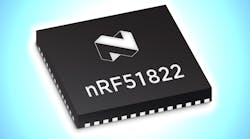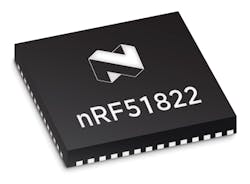This file type includes high-resolution graphics and schematics when applicable.
Systems-on-a-chip (SoCs) have become indispensable in today’s designs, powering applications ranging from cellular infrastructure and radar to test-and-measurement equipment, among many others. SoC types include highly integrated RF transceivers that combine RF, mixed-signal, and digital sections in a single device. Such devices, in some instances, can slash the amount of required external components and ultimately reduce costs.
Currently, the Internet of Things (IoT) is prompting chip makers to develop SoC-based products to support a vast amount of requirements. SoCs will also need to satisfy more difficult requirements in the future, such as the challenges associated with upcoming 5G networks.
“5G and massive multiple-input, multiple-output (MIMO) are driving the need for denser, lighter, smaller, and more power-efficient base stations,” says Nitin Sharma, senior director of marketing and applications for the RF Transceiver product line at Analog Devices (www.analog.com). “SoC solutions need to address this by means of higher levels of integration, wider bandwidths, and lower power consumption.”
SoC Challenges and Capabilities
Designing SoCs does not come without its challenges. For example, sensitive RF/analog circuitry must be protected from noisy digital circuitry to ensure acceptable spurious performance.
“Jointly locating sensitive RF/analog circuitry and large digital blocks is certainly one of the most challenging tasks,” says Sharma. “As the RF performance requirements increase to meet market demands, focus needs to be on spurious performance. With multiple power supplies, attention is required to ensure that sensitive analog circuits are protected from digital blocks that are large and noisy. In addition, with the inclusion of multiple high-performing phase-locked loops (PLLs), isolation between the voltage-controlled oscillators (VCOs) becomes critical. Without proper design techniques, these issues could generate undesired spurs that could severely limit the performance and flexibility of the end product.”
Engineers at Analog Devices utilize various techniques to develop RF transceiver SoCs that can achieve wideband, spurious-free performance while maintaining isolation requirements. For example, the company’s AD9361 and AD9364 RF transceivers (Fig. 1), which are well suited for a broad range of applications, operate from 70 MHz to 6 GHz.
Many other companies produce SoCs to support multiple applications. Nordic Semiconductor, for instance, offers low-power wireless chips, as well as reference designs. Its nRF51822 and nRF52832 multi-protocol SoCs enable applications like Bluetooth Smart, among others (Fig. 2). Another device, the nRF9E5 SoC, is a multi-band, sub-1-GHz solution. The company stretches beyond simply SoCs by providing several development kits as well.
Broadcom also delivers chips that find homes in a wide range of applications. The company, which was recently acquired by Avago Technologies, just introduced the BCM43012 Wi-Fi/Bluetooth combo chip for mobile platforms and accessories. The chip integrates power amplifiers (PAs), low-noise amplifiers (LNAs), and power management, enabling bill-of-material (BOM) cost reductions and small system footprints. On top of that, battery life of the BCM43012 is as much as three times longer as previous Broadcom combo chips.
The Internet of Things
The IoT is spurring chip makers to to develop integrated solutions to support different facets of the burgeoning network. In fact, a large number of SoCs have recently emerged to enable IoT applications.
“We believe that the next big thing will be a trillion wireless things connected to form the IoT,” says Svenn-Tore Larsen, CEO at Nordic Semiconductor. “To meet the technological needs of the IoT, we launched an IPv6 over Bluetooth Smart solution that enables end-to-end Internet communications, thus easing the development of IoT applications.
“Our sales increase in 2015 was driven heavily by early IoT-related applications, such as sports and fitness, consumer health, connected toys, location beacons, smart watches, and wearables,” he continues. “But we still feel that this is only the start of the IoT revolution. There is enormous potential in many sectors, such as the smart home, industrial automation, automotive, asset tracking and management, and retail/point-of-sale systems.”
Several new IoT-based products have surfaced of late. Qualcomm just launched its new CSR102x brand, which is a Bluetooth Smart SoC product line. The CSR102x series is optimized for IoT-specific applications, including wireless remote controls, simple smart watches, and home-automation solutions and beacons. This line of SoCs is intended to simplify integration into each target application, thereby eliminating expensive interface components. A development kit, expected to arrive later this year, is comprised of a programmer base board and pluggable CSR102x SoC module.
For its part, MediaTek is fresh off its announcement of the MT7697 SoC, which enables Wi-Fi and Bluetooth connections for smart gadgets and wearables. The MT7697 incorporates a PA with transmit power as high as +10 dBm. A dual-band Wi-Fi version of the chipset, the MT7697D, supports both 2.4- and 5-GHz applications. The MT7697 is expected to be available in the first half of this year.
In other recent news, Telink Semiconductor launched the TLSR8269, which is an all-in-one SoC for the IoT. The TLSR8269 combines the functionality of all 2.4-GHz IoT standards in a single SoC. The company believes that the TLSR8269 can be a single-chip solution for devices ranging from smart-home applications to wireless toys. In addition, the TLSR8269 integrates hardware acceleration to support complicated security operations.
A large number of companies offer SoCs today, and this article provides some examples of recent activity in this arena. Other companies are providing their own innovative solutions, too. With the emergence of the IoT, expect chipmakers to push the performance envelope even further to enable the required connectivity. Simply put, cutting-edge SoCs will be at the very heart of it all.
Looking for parts? Go to SourceESB.



